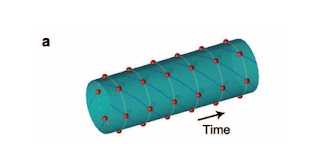 |
| Credit @ link below |
TECHNOLOGY REVIEW: A couple of months back, we looked at the notion of time crystals, an idea put forward by Nobel-prize winning physicist Frank Wilczek and his pal Al Shapere.
These guys examined the fundamental properties of ordinary spatial crystals and asked why similar objects couldn't exist in the dimension of time instead.
One of the basic properties of spatial crystals is that they form when a system drops to its lowest possible energy state. They are not the result of adding energy to a system, but of taking it away. All of it.
Another basic property is that when these objects reach their lowest energy configuration, their symmetry breaks down. Instead of being the same in all directions, like the laws of physics, these objects become the same in only a few directions. It is this symmetry-breaking and the periodic structure it produces that defines crystals.
Wilczek and Shapere persuasively argued that there's no reason why similar periodic structures couldn't exist in time. And they said that finding them would give physicists a new way to study the process of symmetry-breaking and the laws of physics behind it.
There was just one problem, however. These guys hadn't worked out how to build a time crystal.
That changes today with the work of Tongcang Li at the University of California, Berkeley and a few buddies who say they've worked out how to do it. These guys say they know how to create an object in its lowest energy state that shows periodic structure both in space and time--a space-time crystal.
I had the pleasure of meeting Tongcang Li just before his PhD dissertation defense under Mark Raizen. This obviously builds on his research with the Raizen Group. This is amazing!
Physics arXiv: Space-time crystals of trapped ions
Comments